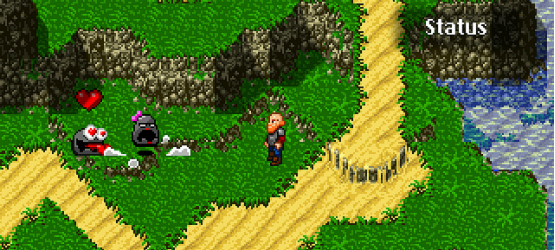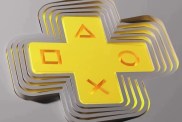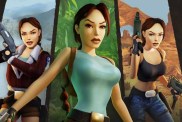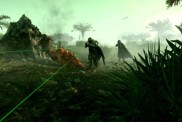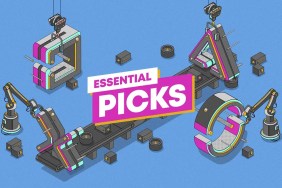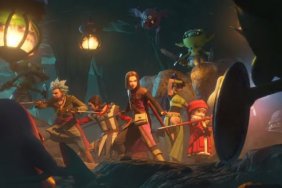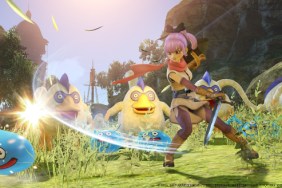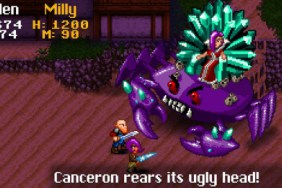I recently had the opportunity to sit down with Adam Rippon, Creative Director at Muteki Corp. We spent time talking Dragon Fantasy Book, Mode 7, and rocks with makeup on.
Enjoy!
For those who don’t know, can you catch us up on what happened in the first Dragon Fantasy Book?
For people who haven’t played Dragon Fantasy Book I, the short version goes like this: Ogden, a 46 year old retired hero has spent 30 years not doing much at all. Then one day he has to rescue the Prince of Westeria from a dark knight who interrupted the Westerian coronation ceremony. During his epic journey he meets a group of rowdy pirates who help him on his way to defeat the Dark Lord. Then, the Prince’s brother Anders discovers an ancient talisman that has something to do with the Dark Lord, and has the pirates take him to the Eastlands to study it. Finally, in the Eastlands, a thief and his niece steal that talisman and run off with it. Those three plotlines each comprise a chapter.
Dragon Fantasy Book II picks up right after Book I ends and is basically chapters four, five, and seven, but all the backstory is completely unnecessary to follow Book II’s story. Basically, all you need to know is you’re in search of a voidstone, and the Dark Lord himself tells you that right at the beginning of the game!
Some of Dragon Fantasy Book II seems to not take itself very seriously, was it difficult to build, what many would consider, a JRPG that doesn’t have melodrama? Or am I off course entirely here?
Neither game in the series takes itself very seriously, but that doesn’t mean it’s not a serious story. The world is truly at stake, and as the story has progressed it has gotten substantially darker than the first chapter. But, even the horrors that the heroes of Westeria have faced so far haven’t been enough to change the fact that they’ve all become good friends and enjoy joking with each other. So, while the game was very difficult to build, I can say that the story was actually one of the easier parts for me – most of these characters have been in my brain for many, many years, and so they just pour out onto the page easily.

Watching the E3 combat trailer, was there any bit of snark making the first enemy a giant enemy crab?
Well…yes, but it might not be the snark you’re thinking of! The giant crab is actually a reference to my friend Ben McGraw’s upcoming title, “Sully: A Very Serious RPG”. We actually named both the crab and the clam enemies after him, because most of the characters in his game are seafood.
I keep bringing up trailers… But there was a rock thing with makeup on, explain.
That would be Ragnarock, she’s the boss of the underground cavern on the Pirate Island. She’s one of the Grand Rocks, which we may get into more in Book III. She’s based on Mama Fratelli from The Goonies, which was a huge inspiration behind the whole pirate island sequence in Book II.
The original idea was to move through 8-bit into 16, why toss the idea and go straight to 16?
Dragon Fantasy Book I was the 8-bit original, with three chapters that progressively built up into the later years of NES-style gaming. Of course, by the time we released it on PSN, we had done a SNESstyle remake of the game, and you could turn that on or off with a switch. With Book II it’s 16-bit all the time, and then someday with Book III we’re hoping to build an PSX/N64-era RPG, complete with 3D characters, fancy camera work, etc. We’ll work diligently to stick to the core concepts of Book II, just in 3D.
Why not do any type of polygonal work? Do you think good 16-bit holds up better than early polygon work?
I do think good 16-bit holds up better than early polygonal work, but it is definitely easier to do a 3D game these days. Honestly, Book II took us a lot longer than expected because we had so many characters to animate. Our Art Director, Kevin James, can attest to this with the bloody nubs where his fingers used to be. I think we’re all very much looking forward to doing Book III in 3D just so we can use all the tools and conveniences afforded to modern game development!
What is it like recreating early 3D effects like Mode 7 in current hardware?
Surprisingly difficult. Mode 7 was amazing in its ability to draw effectively infinite landscapes that repeat forever at very little performance cost. With 3D it’s easy to replicate that look, but to draw a landscape that goes off far into the distance means drawing a ton of polygons. Our engine actually supports a ton of 3D features, but rendering our multi-layered tile maps large enough to stretch off into the horizon was more of a challenge than one might think initially.
The boss battles seems inspired by the JRPGs of old, but taken to a new level in terms of scale. How did you go about designing the encounters?
We built the game’s design around the concept of a living world from the beginning. We wanted to go very far away from the static, randomly encountered monsters seen in Book I, because honestly, no one on the team is actually a fan of random encounters, except for purposes of nostalgia. With Book II every enemy on the map can potentially join in the same battle, and we did everything we could to accommodate that. 99% of the time battles will be more controlled, and we designed most of them with preferred tiles for up to 4 players and up to 4 enemies. But if you run around and get enemies chasing you and then get caught, you could face upwards of a dozen enemies. Battles like that will be far more chaotic, but we try to calm that by only allowing up to 7 enemies to attack in a single round. The actual number is the number of player party members (up to four), plus three. Math is fun!
Are cross buy and cross save being supported between Vita and PS3?
Yes and yes!
